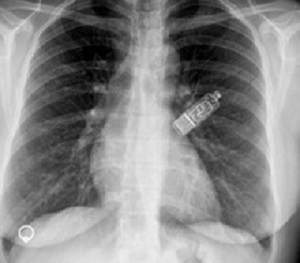 The use of implanted cardiac monitors researchers detected a substantial incidence (nearly 30%) of previously undiagnosed atrial fibrillation (AF) after 18 months, in patients at high risk of both AF and stroke.
The use of implanted cardiac monitors researchers detected a substantial incidence (nearly 30%) of previously undiagnosed atrial fibrillation (AF) after 18 months, in patients at high risk of both AF and stroke.
Atrial fibrillation affects millions of people worldwide and increases with older age, hypertension, diabetes, and heart failure, conditions that are associated with increased stroke risk. Atrial fibrillation episodes may be symptomatic, asymptomatic (silent AF), or both. Heart failure or stroke can be the first clinical manifestation of AF. Recognition of previously undiagnosed AF and initiation of appropriate therapies is essential for stroke prevention.
Minimally invasive prolonged electrocardiographic monitoring with small, insertable cardiac monitors (ICMs) placed under the skin could assist with early AF diagnosis and earlier treatment. Dr James A Reiffel, of the Columbia University College of Physicians and Surgeons, New York, and colleagues conducted a study in which 385 patients received an insertable cardiac monitor.
The patients were at high risk of both AF and stroke; approximately 90% had nonspecific symptoms potentially compatible with AF, such as fatigue, breathing difficulties, and/or palpitations, and had either three or more of heart failure, hypertension, age 75 or older, diabetes, prior stroke or transient ischemic attack (TIA), or two of the former plus at least one of the following additional AF risk factors: coronary artery disease, renal impairment, sleep apnea, or chronic obstructive pulmonary disease. Patients underwent monitoring for 18 to 30 months.
The researchers found that the detection rate of AF lasting six or more minutes at 18 months was 29%. Detection rates at 30 days and 6, 12, 24, and 30 months were 6 percent, 20%, 27%, 34%, and 40%, respectively. Median time from device insertion to first AF episode detection was 123 days. Of patients with AF lasting six or more minutes at 18 months, 10 percent had one or more episodes lasting 24 hours or longer, and oral anticoagulation therapy was prescribed for 72 patients (56%).
The study notes some limitations, including its modest size.
The authors write that as the AF incidence was still rising at 30 months, the ideal monitoring duration is unclear. "Further trials regarding the value of detecting subclinical AF and of prophylactic therapies are warranted."
Abstract
Importance :In approximately 20% of atrial fibrillation (AF)–related ischemic strokes, stroke is the first clinical manifestation of AF. Strategies are needed to identify and therapeutically address previously undetected AF.
Objective :To quantify the incidence of AF in patients at high risk for but without previously known AF using an insertable cardiac monitor.
Design, Setting, and Participants :This prospective, single-arm, multicenter study was conducted from November 2012 to January 2017. Visits took place at 57 centers in the United States and Europe. Patients with a CHADS2 score of 3 or greater (or 2 with at least 1 additional risk factor) were enrolled. Approximately 90% had nonspecific symptoms potentially compatible with AF, such as fatigue, dyspnea, and/or palpitations.
Exposures: Patients underwent monitoring with an insertable cardiac monitor for 18 to 30 months.
Main Outcomes and Measures :The primary end point was adjudicated AF lasting 6 or more minutes and was assessed at 18 months. Other analyses included detection rates at points from 30 days to 30 months and among CHADS2 score subgroups. Median time from insertion to detection and the percentage of patients subsequently prescribed oral anticoagulation therapy was also determined.
Results: A total of 446 patients were enrolled; 233 (52.2%) were male, and the mean (SD) age was 71.5 (9.9) years. A total of 385 patients (86.3%) received an insertable cardiac monitor, met the primary analysis cohort definition, and were observed for a mean (SD) period of 22.5 (7.7) months. The detection rate of AF lasting 6 or more minutes at 18 months was 29.3%. Detection rates at 30 days and 6, 12, 24, and 30 months were 6.2%, 20.4%, 27.1%, 33.6%, and 40.0%, respectively. At 18 months, AF incidence was similar among patients with CHADS2 scores of 2 (24.7%; 95% CI, 17.3-31.4), 3 (32.7%; 95% CI, 23.8-40.7), and 4 or greater (31.7%; 95% CI, 22.0-40.3) (P = .23). Median (interquartile) time from device insertion to first AF episode detection was 123 (41-330) days. Of patients meeting the primary end point, 13 (10.2%) had 1 or more episodes lasting 24 hours or longer, and oral anticoagulation therapy was prescribed for 72 patients (56.3%).
Conclusions and Relevance: The incidence of previously undiagnosed AF may be substantial in patients with risk factors for AF and stroke. Atrial fibrillation would have gone undetected in most patients had monitoring been limited to 30 days. Further trials regarding the value of detecting subclinical AF and of prophylactic therapies are warranted.
Authors
James A Reiffel, Atul Verma, Peter R Kowey, Jonathan L Halperin, Bernard J Gersh, Rolf Wachter, Erika Pouliot, Paul D Ziegler
[link url="https://www.sciencedaily.com/releases/2017/08/170827101755.htm"]JAMA material[/link]
[link url="http://jamanetwork.com/journals/jamacardiology/fullarticle/2650790"]JAMA Cardiology abstract[/link]
